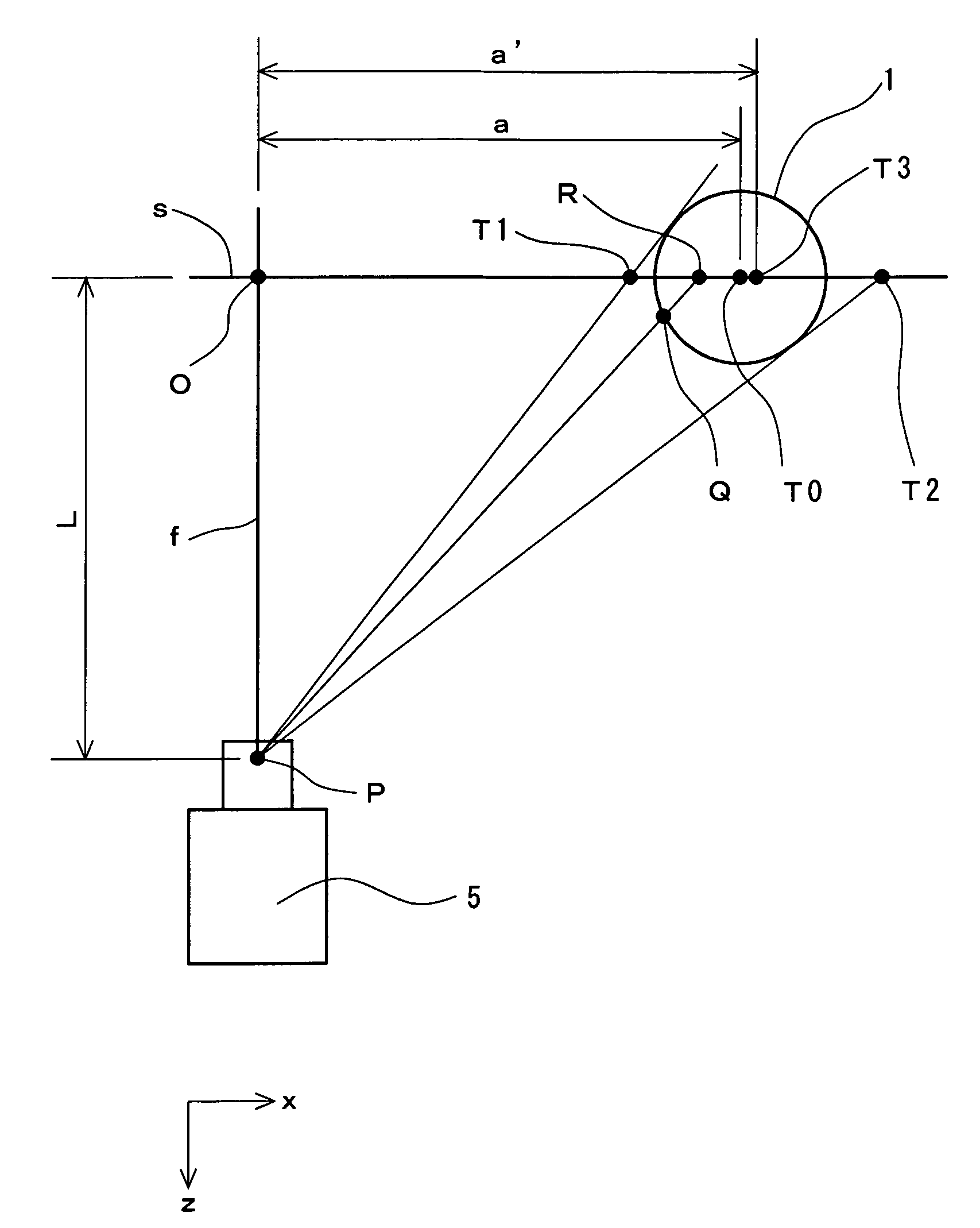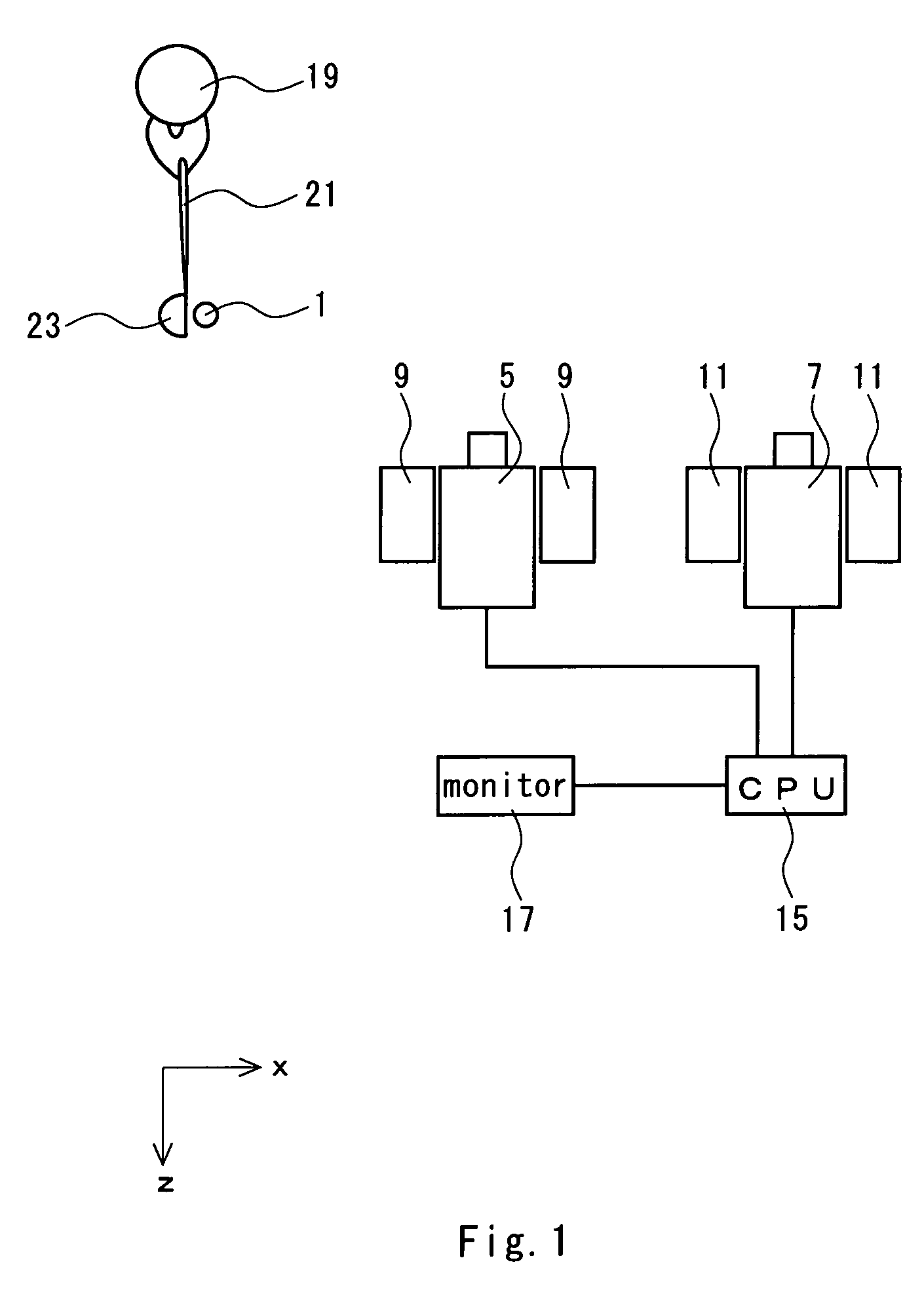Ball motion measuring apparatus
a technology of motion measurement and ball, which is applied in the field of ball motion measurement apparatus, can solve the problems of difficult to predict the position of golf balls, reduce the angle of view of balls in images obtained by cameras having a great angle of view, and complicated work for often changing the position of cameras, etc., and achieve high precision
- Summary
- Abstract
- Description
- Claims
- Application Information
AI Technical Summary
Benefits of technology
Problems solved by technology
Method used
Image
Examples
experiment 1
Experiment Example A
[0056]A CCD camera having a wide-angle lens was prepared for first and second cameras. In the CCD camera, a visual field range in a horizontal direction is 250 mm (a horizontal view angle of 45.24 degrees) when a distance between a focal point P and a reference plane is 300 mm. The positions of both cameras are regulated such that a ball image was photographed in almost the central part of an original image and a golf ball mounted on a tee was hit. The flying golf ball was photographed in a shifted timing by means of two cameras so that two original images were obtained. The original images were displayed on a monitor and a flight speed, a launch angle, a backspin rate and a sidespin rate of the golf ball were calculated through an operation for pointing a recognition mark by an operator. The pointing operation and the calculation were repeated ten times to obtain a variation (4×σ).
experiment example b
[0057]Original image data obtained in the experiment example A were subjected to a magnifying process having a double magnification ratio so that a magnified image was obtained. Based on the magnified image, the same pointing operation and calculation as those in the experiment example A were repeated ten times. Thus, a variation (4×σ) was obtained.
[0058]
TABLE 1Result of Experiment 1ExperimentExperimentExample AExample BType of lensWide angleWide angleMagnifyingNo× 2correction ratioDistortion correctionNoNoOblique correctionNoNoPosition of ball imagein original imageFirst cameraCenterCenterSecond cameraCenterCenterVariationFlight speed (m / s) 0.18 0.11Launch angle (deg.) 0.31 0.15Backspin rate (rpm)18088Sidespin rate (rpm)16884
[0059]In the Table 1, a measured value has a smaller variation in the experiment example B than that in the experiment example A. Consequently, it is apparent that precision in measurement can be enhanced by the magnifying process.
experiment 2
Experiment Example C
[0060]The same first and second cameras as those in the experiment example A were prepared. The position of the first camera was regulated such that a ball image can be photographed on the lower left part of an original image and the position of the second camera was regulated such that a ball image can be photographed on the upper right part of the original image. Then, a flying golf ball was photographed by means of the two cameras in a shifted timing. An original image thus obtained was subjected to a double magnifying process. Thus, two magnified images were obtained. The magnified images were displayed on a monitor so that a read value was obtained through an operation for pointing a recognition mark by an operator. A flight speed and a launch angle of the golf ball were calculated from the read value. The pointing operation and the calculation were repeated ten times. Thus, a mean value was obtained.
PUM
 Login to View More
Login to View More Abstract
Description
Claims
Application Information
 Login to View More
Login to View More - R&D
- Intellectual Property
- Life Sciences
- Materials
- Tech Scout
- Unparalleled Data Quality
- Higher Quality Content
- 60% Fewer Hallucinations
Browse by: Latest US Patents, China's latest patents, Technical Efficacy Thesaurus, Application Domain, Technology Topic, Popular Technical Reports.
© 2025 PatSnap. All rights reserved.Legal|Privacy policy|Modern Slavery Act Transparency Statement|Sitemap|About US| Contact US: help@patsnap.com



